




Announcements and notices may be sent to mousemageditors@gmail.com for inclusion in future issues.





Announcements and notices may be sent to mousemageditors@gmail.com for inclusion in future issues.
Joseph Dole is a writer and artist serving a life sentence at Stateville Correctional Center. He is the Policy Director of Parole Illinois, a group urging the return of discretionary, earned parole opportunities for prisoners in Illinois, where parole was abolished in 1978. His writing and art can be found at his website, PI’s page, the Real Cost of Prisons project, and his Facebook page.










EN: This is section 3 of “In Arboreal Time, A Collection of Photographs of Me Standing in the Middle of Nowhere,” which appeared in TiVo: Five Poems, published by Frances House Press. The front matter of TiVo and a complete scan of “In Arboreal Time” appear below.
la so
so la
so me
re me fa re fa me ti me
la so do re me fa so la ti do
la so do re mi la so ti re re me so
oh look, the marzipan ambush,
oh look, a burnt marshmallow,
oh look, Judy Garland, Avey Tare,
The corpse of the artist, oh look,
oh look, the day in advance,
oh look, samaritan duck meat,
shook shook a mind portico of
halberd Montgomery Montgomery
Humbert Humbert, oh look, Heaven’s Door,
oh look, oxtail soup,
oh look, throng in corridor,
oh look, leagues of Sung Tongs pustule,
oh look, lake como play tide in a movie,
oh look, of all stripes pruning the hedges
foremostly Advance Auto Parts,
oh look, under a curtain of Mantuan
doggerel in a whirlwind, Miss Schaumburg
oh look, the site is down
the sun is down, porter is slow,
I’m in Penelope art gallery selfie,
Miss Schaumburg, Johnson & Johnson
Geriatric capacity vial deliverer
closed down the street for Krabs,
back fused futile origami ugly duckling
do re mi fa sol, do re mi goreng
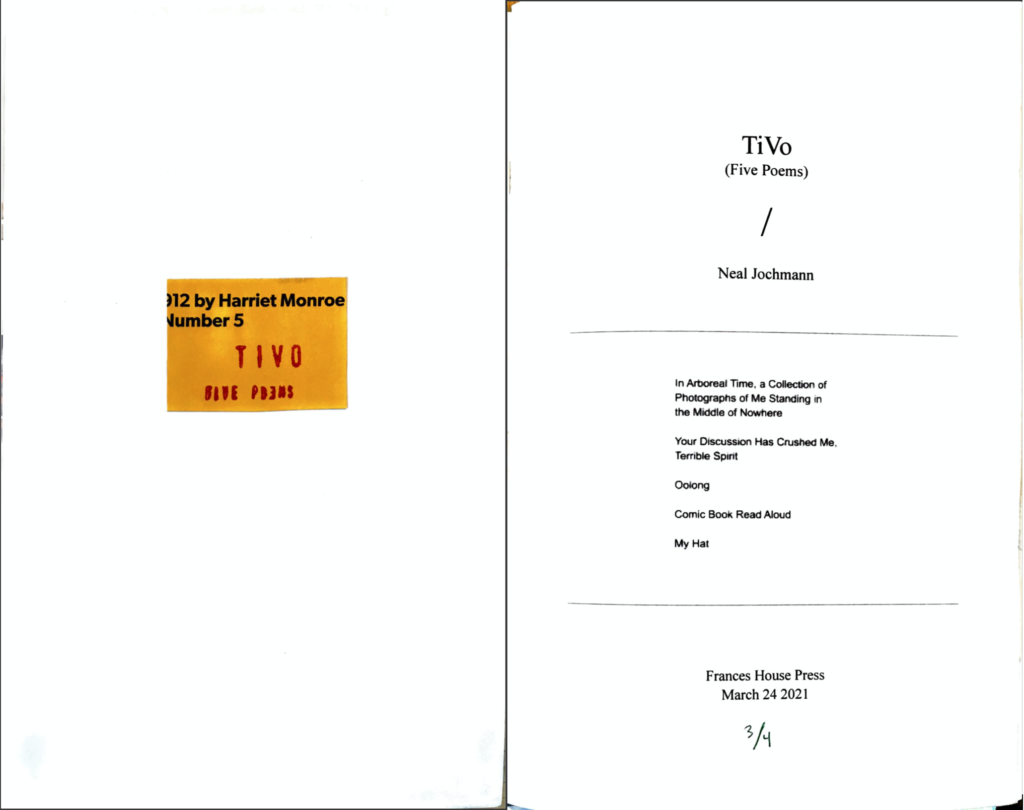
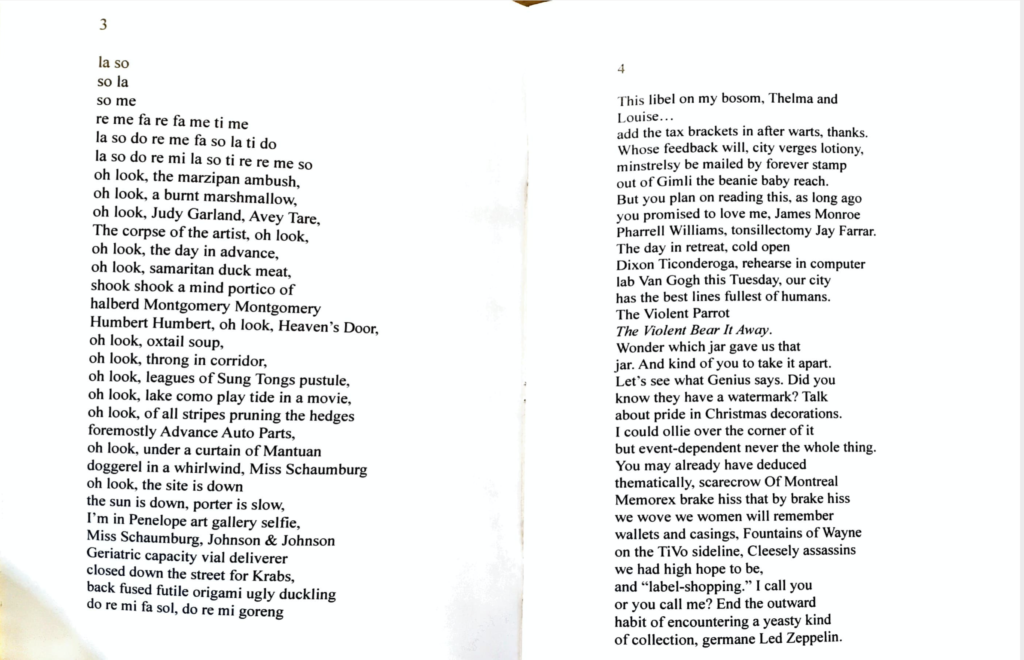
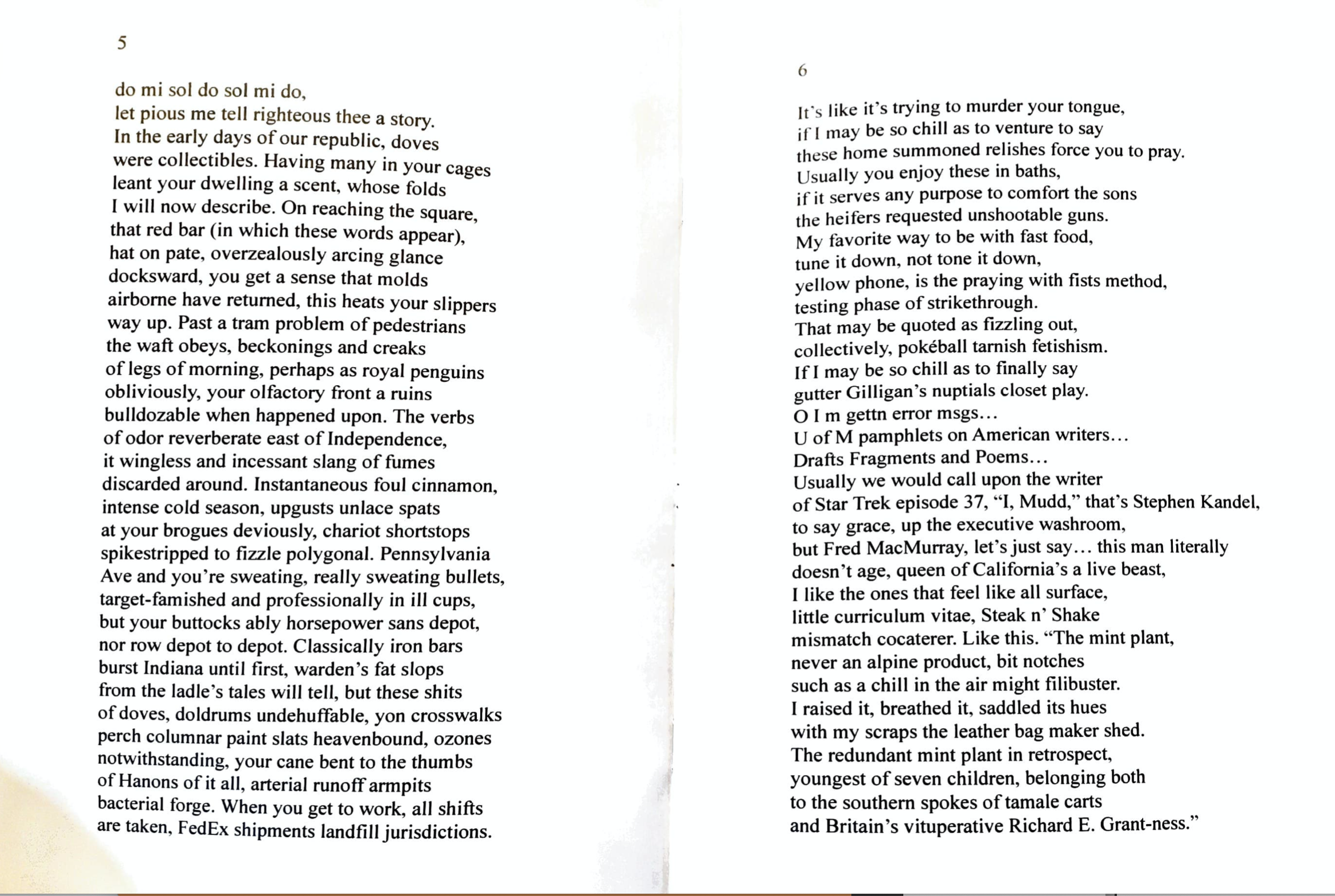
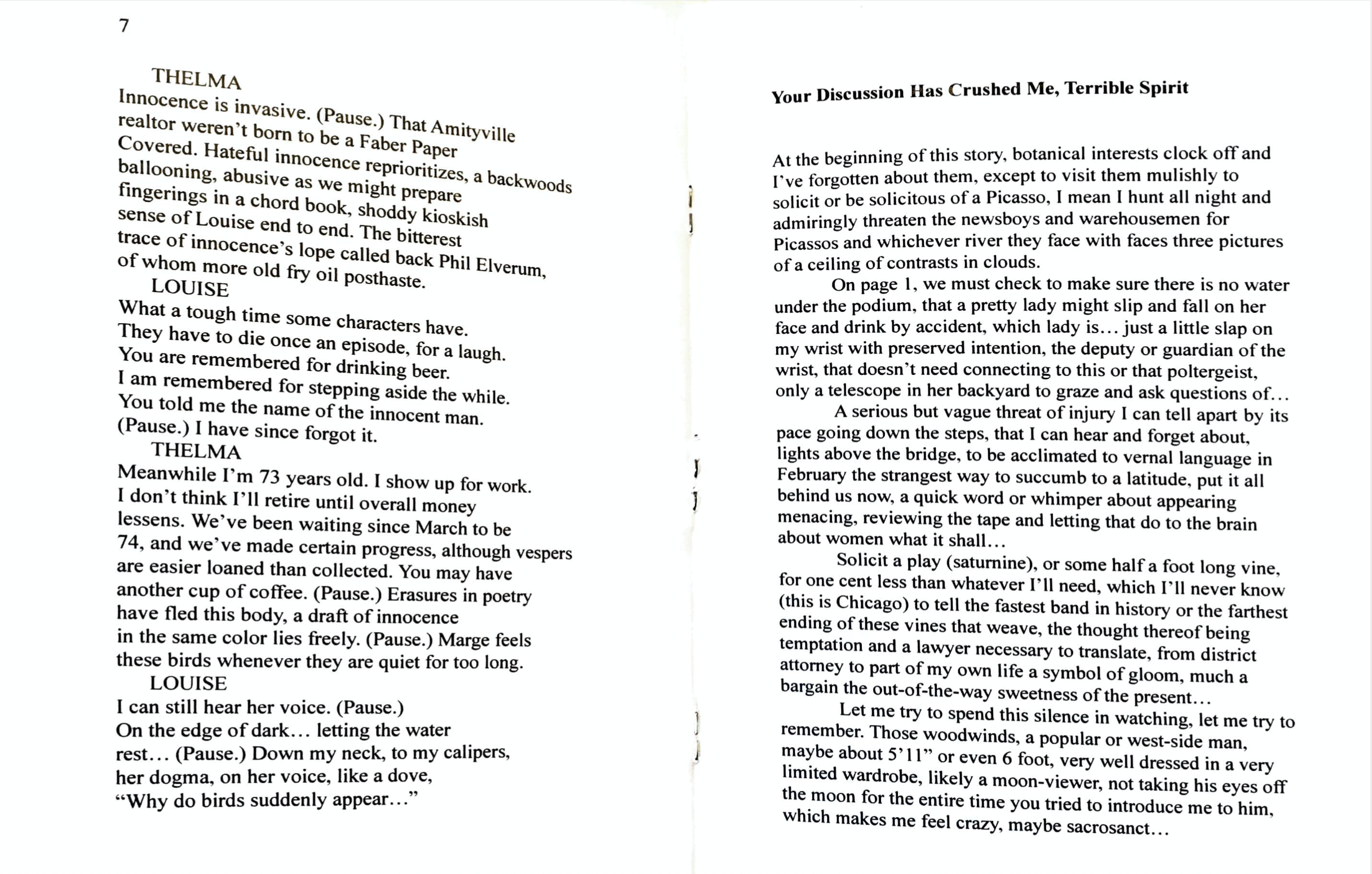
How many ways are there to slough off the responsibility of a self? Let me count some…
“Not having been born an animal is a secret nostalgia of mine.” Clarice Lispector – Água Viva (1973)
“[T]o be an animal, born at the opening of the eye, going only forward, and, at the end of the day, shutting out memory with the dropping of the lid.” Djuna Barnes – Nightwood (1936)
“Come into animal presence. / No man is so guileless as the serpent.” Denise Levertov – “Come into Animal Presence” (1961)
“To remember is to betray / Nature, since the nature of yesterday / Is not nature. What has been is nothing, / Remembering / Is failure to see. / Move on, bird, move on, teach me / To move on.” Fernando Pessoa – from The Keeper of the Flocks (1914)
“When I went outside, the wind began to blow. It was coming from a long way off with nothing to stop it. It turned me around. It opened my mouth. It undid my hair and lifted my skirt. It scattered me just like I liked.” Kathryn Scanlan – The Dominant Animal (2020)
EN: This is the “overture” to a forthcoming eight-part narrative poem, ZOSO.
OVERTURE: SESOSTRIS
(Adventures in the Unknown Interior of America)
 ICE
ICE
Slow but certain
LAND
Prepared
Mammoth runs
SKY GIANT
Makes us lake
Greater
ONE GREAT WATER
Above and greater
Than all the later waters
BY WATER
Where the spirit smoke
To gather
AND RELEASED
To migrate down
Creating
AND DESTROYING
Blasting carving rock
Ox-bowing the land
TO FLATNESS
Between the bluffs
WITH LIGHTNING
Treasure of the eagle
AND GREAT BEASTS
Beneath the water
In the latter
DAYS OF STONE
And bone
In the woodlands
AND THE BOTTOM
Hollowed out
Low and fertile
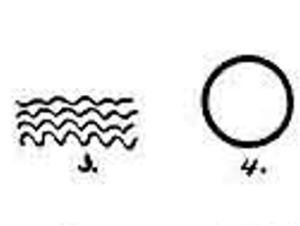
Center
Slow flow of agate
Rapid trade of corn
Not the only plumed serpent
Not the only way to sky
Not the only plan of fasting
Not the only flash of gleaming eyes
*
THE SU-UN! HE CO-OME!
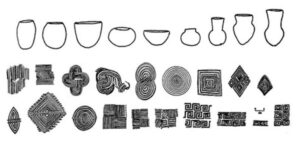
Almost no living individual
Saw the valley of the sun and moon
And the city stockaded round the mound
But the great river would ferry good arrows, pottery
The common breath of peace pipe
“urban” the seat of a “state”
“controlled” resources and “dominated” trade
And life which every way it flows
And how far to walk the site
Shoulder lifting the canoes
Along the journey to the next
Which must connect and be made right
The women: one handful at a time


Sequence: first-line to second multi-mound
To moundless third-line hamlets
a globular funnel “juice press” form
the water bottle form
the fabric-impress pan
as well as red-filming as surface
finish, a type compared
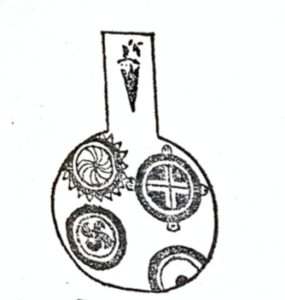
keep in mind the potters teach
keep in mind the pots and bottles hold
what the days and trading hearts intend
Oh to touch the dream
That hides inside and never’s seen
far flung
high status
to bury
a blanket of thousands of shell beads
400 arrows
uncut mica sheets
sheet copper
and four retainers
“beheaded and behanded”
Mississippianization!
(Then next and now!)
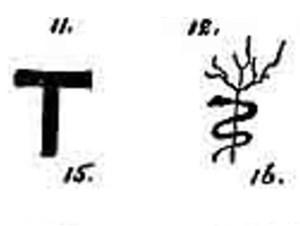
No millennial mass migration to repeople
But steady rain of influence from the south
Up down to the bottoms
Town squares
But then, descend

DESCEND: “How beautiful the sun is, O frenchman, when thou comest to visit us! All our village awaits thee, and thou shalt enter all our Cabins in peace.”
DESCEND: They live on corn and other fruits of the earth, which they cultivate on the prairies. They eat 14 kinds of roots, which they find in the prairies; they made me eat some and I found them good and very sweet. They Gather from trees and plants 42 different kinds of fruits, all of which are excellent; and catch 25 sorts of fish — among them, the eel. They Hunt the roebuck, the bison, the Turkey, the Wildcat, a species of tiger, and other animals; they Reckon up 22 kinds of these, and some 40 kinds of game and birds. I have been told that, lower down the river, there are saline springs, and that they make salt from them; I have not yet seen the experiment tried. I am also assured that, not far from their village, there is slate-stone as fine as ours. I have seen in this country red Copper — which is found, as elsewhere, in little pieces, on the banks of the river. And, lastly, they assure me that there are here rocks with pitch. The savages Cut them, and find silver — like veins; they pulverize these and make of them a very fine red paint. They also come across other veins, from which the pitch oozes; this, when thrown into the fire, burns like ours.
DESCEND: I WRITE you news concerning the affairs of the Illinois, some of which is good and some of which is bad.

We come from the land of the ice and snow
From the midnight sun where the hot springs flow
CF. BROWNELL POETRY MAGAZINE XLI/VI 1933
 When first my father settled here,
When first my father settled here,
Make it a lost county of Virginia
’Twas then the frontier line:
Make it ripe for speculation
The panther’s scream, filled night with fear
Alienate discovered to the sovereign
And bears preyed on the swine.
Homestead, and emancipate
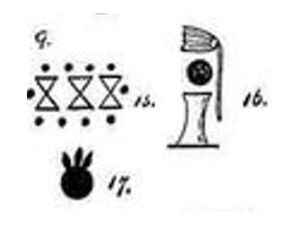
The state archaeological survey insists for years
That the mounds are of the glaciation
Worthless Worthen!
Moon-y almanacker!
Get easement in fee for the railroads

Leaving the latter aside, then, I shall speak of the king who came after them, whose name was Sesostris. This king, the priests said, set out with a fleet of long ships from the Arabian Gulf and subjugated all those living by the Red Sea, until he came to a sea which was too shallow for his vessels.
But adjustable buoyant air chambers of a steam boat or other vessel for the purpose of enabling their draught of water to be readily lessened to enable them to pass over bars, or through shallow water, without discharging their cargoes!

**** PRINCE OF TYRE
SYRIAN PURPLE
THE THIRD DEGREE
THIRD PART OF THE DAY AND NIGHT
THE DAY OF JUBILEE
THE NIGHT OF NINETEENTH CENTURY
THIRD PART DRY GOODS DAY
THIRD DEGREE BUILT UP BY NIGHT
MEASURE, THE DRY GOODS
BEHOLD, THE BUILDER ****

9 FOLD SURVEY EACH TIME
BITUMEN DOWN UNDER LAND
So a railroad track
Blast
Bluffs
Camp
Hunt
Fish
Split
Rails
Cree’
Sote
Beams
Bolt
Weighed
Up
Pig
Ir’n
Between such speculation sully us a calumet for a cigar
Harness races police personnel horsetrade logroll up a deal
Migrants croppers reavers bordering the copses and state line
We’re not doing cotton or much wheat but apples, pears, berries
Port
Call
Barge
Load
Deal
Truck
Hoist
Sprain
Mend
Mark
Latch
Deal
Share
Deal
Share

|
Grant’s HQ downriver
|
If it weren’t for coal,
|
|
February 1, 1924 Young conducted his biggest raid ever and led a parade of 125 hostages around the public square in Benton before they were arraigned before the U. S. Commissioner there. Armed with pearl-handled automatics and a sub-machine gun, Young strutted in front of the queue. This display of arrogance only aggravated the hostility between Klan and anti-Klan factions.
|
BETWEEN THEN WAR IN THE |
*
|
1924 Birger’s Gang and the rival Shelton’s gang fought for control, which erupted into feuds between the gangs and against the Klu Klux Klan. Charlie killed two men within three days. The first killing took place at the Halfway House and with the second killing he took a bullet in his lung and was taken to the Herrin Hospital. In both killings, Birger was cleared of all charges under the plea |
THE SLAVE HOUSE
|
|
|
Gillespie, Illinois, August 31, 1932 The largest procession of miners that ever passed over the roads of Illinois headed for Franklin County on Wednesday of last week. Thousands and thousands of automobiles and trucks lined the highways leading from Springfield, Nokomis, Pana, Hillsboro, Mt. Olive, Staunton, Gillespie, Belleville, Sesostris and other places. |
*
|
January 24, 1925 A Herrin police officer walked into a cigar store, saw Young with his bodyguards, drew his pistol and shot and killed Young and his body guards. The Klan held a funeral that was attended by more than 15,000 people. April 1926 Charlie Birger and the Shelton Brothers attacked the remaining Klan leaders in Herrin. The Klan was left to bury its own dead and the coroner ruled that the deaths were homicides “by parties unknown.” |
|
|
Ward Chapel located in Cairo, |
All of this great cavalcade met at the Labor Temple where the procession was formed before the march was taken up. Every man was warned that under no circumstances would he be allowed to carry arms, not even a pocket knife. This mission was to be one of peace and their intent was to persuade the miners of Franklin and Seth Counties to cease work and join with them in an earnest endeavor to try and secure a reasonable wage for their work.
|
*
|
October 1926 The Birger and Shelton Gangs were at war. Both gangs built trucks converted into armored vehicles. Birger got word that Shelton’s truck was at Joe Adam’s garage for repairs and demanded Adam’s turn it over to him, he refused to do so. Two months later two men appeared at Adams’s house with a letter they stated was from Carl Shelton. While Adam’s was reading the letter, they drew their guns and shot him dead, then burned the garage down.
|
WHEREAS, |
|
and WHEREAS, Many of our rivers, streams, forests, trails, islands, towns, and landmarks bear important cultural ties |
After the miners had been led into a trap, having been directed over a wrong road, they were met by a barrage of machine gun fire from each side of the road, and the highway became a living hell. Autos were disabled, tires punctured, holes shot through the bodies and radiators of the of the autos, while the men taken by surprise deserted their autos, and ran for the corn fields and other places in order to save their lives. Such a sight was never before witnessed in Illinois and we hope that it will never be again.
|
*
|
Around the same time stories developed that State Trooper Lory Price and Charlie Birger were involved in stealing cars. Charlie was said to hide them and Lory Price would then act as though he had found the cars and split the reward with Birger. Needless to say, the trooper and his wife went missing. Story has it that Birger shot the trooper three times and put him into the back of a car still alive and begging for mercy. They dragged the trooper into a field near Sesostris, Illinois and finished him off. Birger’s men kidnapped the trooper’s wife, shot her, and threw her body down an abandoned mine shaft and covered her body with debris. When the story broke five months later, coal miners worked for two and a half days until they found the body. |
Dear Roy, I’m writing you finaly like I said I would do back in Korea. Well what can I say beside I am Married and raising chickens with my Brother in Seth County. Its nothing real spechial but honest work. Write me back if you are Coming thru Illinois like you said. Sincerly, Ken Boyd |
|
|
(I’ve been eating like a sultan since I was 2 days old |
*
|
December 1926 Charlie Birger and some members of his gang shot and murdered West City’s mayor, Joe Adams. June 1927 Charlie Birger was arrested in Franklin County for the December 1926 murder of Joe Adams. This occured after two of his men, Elmo and Harry Thomason turned over evidence to save there own necks. Charlie Birger didn’t control Franklin County like he did Williamson County. This time he was found guilty of murder and was sentenced to hang to death publically at the Franklin County Jail in Benton, Illinois. One of the two who had helped with the killings confessed as the trigger man, and was only given a prison sentence. However Birger was sentenced to hang for the crime. April 19, 1928 At Charlie Birger’s request he wore a black hood instead of a white one to his hanging. He didn’t want to be confused for a Klu Klux Klan member. He was then hanged |
|
|
Creosote, you made a mighty bad break of me; Now, creosote, you’re a dirty robber and a thief; [The guys who lose a type of their own but some who were there and more who weren’t will tell their kid about seeing the legendary hustler win]
|
The miners made a heroic attempt to dash across the Seth County line. On re-entering the county the state highway police, plentifully armed with machine guns, pistols and rifles, used every means of intimidation on the miners, telling them to move on and to keep moving and not to stop in Sesostris.
|
He always liked the song and bought a copy
of the 45 at a Chicago record store and brought it back
to Liverpool. The last public hanging in Illinois
took place there in 1928 — enough material in common with the band
to fill 90 minutes onstage. Local gangster Charles Birger
for the record and, yes, “George Harrison of The Beatles” visited
while on vacation. He had no fear of dying. He was looking forward
to whatever came next. We both believed in reincarnation
and came up with a secret signal so that we would recognise
each other in future lives. In Illinois, where my sister was living
at the time. I went to record stores. I bought Booker T and the MGs’
first album, Green Onions, and I bought some
Bobby Bland, all kind of things. Nobody tore at his clothes
or screamed for his autograph. No squads of police
no gangs of reporters. It was such a relief for him.
Local band The Bantams were playing at the Masons’ Hall
on Lebanon Ave in Sesostris, Illinois, and hearing that George
was a British musician invited him on stage.
There were no throngs of screaming, frenzied young girls,
no gang of reporters, no legions of police, no limo. Together
they played Roll Over Beethoven and a Hank Williams song the first
performance by a Beatle in the US.


Across town big bronze guy with the Garand and the pack. Three columns of names
Across town where school has trophies. High School Boys Basketball Final Four 1983, 84, 85, girls semi-finals, track and field many little champion golds
Across town generations of Chicago suburb youth come for college and never leave
Across town where St. Louis Black Panthers spoke
at a church during the campaign to win the Cairo redevelopment plan
Across town faculty recruits taken to the Michelin-noted roadhouse then keeping to themselves
Across town a hashbrown and a cup of coffee
Across town a fair of summer fruit and blowing glass
Across town a marching band
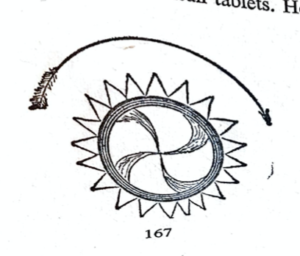
I got my COVID vaccine in March at the combination COVID testing/vaccination/medical marijuana certification/cosmetic dermatology/queer health authorization/adult ADHD diagnosis/ketamine clinic. As a social worker, I self-identified as a member of the 1B category. Some of my colleagues declined to participate at this stage because they did not want to cut the line, but after reading about yoga teachers getting vaccinated as educators and an overwhelming number of suburban moms driving into the city for vaccine appointments, I decided my own vaccination was not likely to be a zero sum tradeoff between myself and a high-risk elderly person of color. In the Uber ride to the clinic, I convinced my driver to get vaccinated and helped him schedule an appointment. The clinic brands itself as a one-stop-shop for INNOVATIVE and EXPRESS care, delivered on-demand. The Uber driver identified the location as a former Mini Cooper dealership.
One week after I received my second dose, the Chicago Department of Public Health shut off the vaccine supply when they discovered the former Mini-Cooper dealership/COVID testing/vaccination/medical marijuana certification/cosmetic dermatology/queer health authorization/adult ADHD diagnosis/ketamine clinicr “knowingly misallocated” 6,000 doses meant to inoculate Chicago Public Schools teachers. I didn’t tell anyone about my vaccination until several months later, when it was more acceptable to share the news.
As an alum of the University of Chicago Folk Festival Coordinating Committee, and in honor of Robert “Bob Dylan” Zimmerman’s 80th birthday, I have taken it upon myself to investigate claims that B.D. was snubbed by the U.C.F.F, which has drawn many illustrious performers over the years including the Stanley Brothers, Pete Seeger, Muddy Waters, Earl Scruggs, and many others. Apparently, Bob was a fan and wanted to perform there in the early ‘60s, but the organizers turned him away.
Moishe Postone recalled Dylan’s connection to Hyde Park in a 2015 interview:
…Bob Dylan was also here first before he went to Greenwich Village. What a little schmuck he was. We all thought, Nothing will ever come of him. He’s just a bad Woody Guthrie imitator. When he started, there were various keepers of the flame. There were the communist kids, for whom folk music meant a very particular thing—Woody Guthrie.
This attitude is confirmed by accounts of Dylan’s unsuccessful audition for the inaugural festival in 1961: “The poor kid wandered around looking miserable,” according to a 2001 account by Paul Levy, a UChicago student who let Dylan stay at his Hyde Park apartment for a few days.”
But it seems like Bob pulled himself together and ultimately had a good time picking and schmoozing at festival-adjacent jam sessions, as Mike Michaels (X ‘61, an organizer of the first fest) recalled:
The festival’s opening reception took place on a Friday evening in Ida Noyes Hall and was filled with performers and students from the University and nearby colleges. It was the height of the folk boom, and having a guitar or banjo was almost as necessary as having a toothbrush—maybe more so. So the instruments were out and the jams were on. I was standing there observing the scene when my roommate, Jon Aaron, AB’64, said, “Mike, this is amazing. There’s the Stanley Brothers”—headlining bluegrass musicians Carter and Ralph Stanley—“over in that room and a gang of musicians in the other, and over in that little alcove is this strange looking guy with a funny hat and a harmonica rack playing his own songs with his guitar!” I looked over, and there he was—funny hat, pudgy face, harmonica in rack, and a guitar.
A few minutes later I had joined the jamming on my mandolin, with my bluegrass buddies Jon on guitar and David Gedalecia, X’64, on banjo. [EN: Some University of Chicago publications note drop-outs from the College with an X in place of their bachelors.] Soon I noticed the guy with the funny hat right next to us, bobbing and bouncing to our music. Well, I figured if he liked us he must be OK, so I introduced myself. He told me that his name was Bob Dylan. It turned out that we both loved Woody Guthrie, and we spent a lot of time that weekend playing together in the dorm. Dylan said he was from New Mexico and that his parents were ranchers. I had no reason not to believe him. (Within the month Dylan traveled to the East Coast and met Guthrie, his major influence and hero.)
I had been hosting a folk music show on the University radio station, WUCB, and on the Monday after the festival, this Dylan guy and I did a show of duets, mostly Guthrie songs.
Mouse Magazine has reason to speculate this snub by soon-to-be dropout college commies is what inspired the famous spite ballad “A Hard Rain’s A-Gonna Fall” and changed music and American history, forever.
Between May 5 and October 31, 1889, Paris welcomed thirty-two million visitors to the Universal Exposition, featuring exhibitions from over forty countries and territories in the Americas, Africa, Asia, and the French Colonies. Commemorating the centennial of the French Revolution under the Third Republic, the expo was the largest and most successful yet hosted by the capital. It was also a touchstone of early modernism, between its inauguration of the Eiffel Tower, public demonstrations of Otis Elevator’s new passenger lifts, and displays of Indigenous and traditional foreign cultures that influenced modernist artists, architects, and composers.
Brazil, along with several Latin American countries, participated with exuberant displays, seeking to present itself as a resource-rich, industrializing nation with a scientific grasp of its natural and anthropological patrimonies. As the last American monarchy, the country was one of few such regimes to participate in the fair—many European countries abstained, frightened by the centennial’s revolutionary symbolism. Still, King Dom Pedro II was enthusiastic about the fair. It was to be the Empire’s last public spectacle: on November 15, 1889, days after the closing of the fair, a military coup toppled the monarchy and established the first Brazilian Republic.
That spectacle was lavishly documented in a special album (pictured here) containing catalogue listings and photographs. Through the quintessentially modern medium of photography, the Empire presented its achievements to a select audience back home and preserved them for posterity. The portfolio, which can be seen in full in the National Library’s Brasiliana Fotográfica collection, bears that distinct air of outdated newness that marks so much nineteenth century boosterist media: the free-standing machines framed almost like aesthetic objects, the overstuffed cabinets signifying a bounty of resources, the wooden typography in a few too many typefaces. It is a relic of the Brazilian state’s voice and gaze in a transitional moment and a record of a historically specific, and sometimes strange, vision of modernity.
Paris Universal Exposition Brazilian Exhibition album cover (1889) Embossed leather 39 x 28 cm Arquivo Nacional
The pavilion of the Brazilian Empire at the 1889 Exposition Universelle in Paris presented a narrative of progessive ascension, moving from a showcase of the country’s natural resources up to its manufactured products, the fruits of industrialization. The ground floor displayed agricultural products such as coffee, tobacco and mate, and extractive resources such as mineral and wood samples. Above, on the first floor, these primary materials were transformed into pharmaceutical products, textiles and clothing, liquors and delicacies, and electrical machines. The second and final floor showcased products of a more sophisticated material culture, including engravings, books, refined ceramics and glassware, medals, and artistic furniture.
Interior of the Brazilian pavilion, first floor (right side of staircase) Albumen print on paper 21 X 17 cm in 39 X 28 cm album Arquivo Nacional
Visitors could also enjoy more experiential displays: a coffee tasting booth, a tropical greenhouse, and a pond populated with Victoria amazonica water lilies. In the Machines Gallery, Brazil was represented by a collection of agricultural equipment loaned by businessman Alfredo Michel. Elsewhere, a special Amazonas pavilion displayed traditional craftwork of the northern Brazilian territory, introduced as part of the “isolated civilizations” section in architect Charles Garnier’s imaginative (and somewhat bizarre) “History of Habitation” exhibition.
The exhibition reflected the work of Brazil’s natural history museums and scientific institutions, then engaged in a process of reorganization around increasingly specialized disciplines and the principle of evolution — as were their European counterparts. This ordered articulation of nature and history was both the epistemological foundation and the visual representation of a new kind of modern state that was “but one option among others” in late nineteenth century Brazil. The museum produced and represented new forms of knowledge that catalogued and distributed human and natural resources in the national territory, allowing these resources to be imagined, valued, and managed in the intertwined systems of capitalism and state power.
It is hard to tell from the array of objects on view how up-to-date Brazil would have seemed to contemporaneous international viewers. For some visitors, the picturesque architecture, exotic gardens, and agricultural portfolios on display confirmed the country’s public image as “a great plantation.” For later commentators, the emphasis on natural resources and exuberant vegetative displays in the “alée du soleil”, as the strip of Latin American pavilions was known, reinforced stereotypes in the eyes of an international audience “predisposed to receive and amplify a caricature of Carnival revolutions and carton-pâté dictatorships”. Yet those displays did produce an accurate statement of Brazil’s role in the modern global economy: lacking a self-sufficient industrial sector, but acting as a sophisticated commodities exporter with rationalized agriculture and mining; still rooted in a colonial monarchy, but, by the efforts of that same regime, perfectly au courant with international institutions of knowledge. And so did those displays produce a statement of power. The exoticised materials and wares also demonstrated the state’s command over its own territory; the various commercial products also showed off a rich and well-managed material culture. I prefer to see the album through this lens, and allow it to reveal its aspirations of power and to challenge (if subtly) modernity’s Northern identity.
View of the mate display case Albumen print on paper 21 X 17 cm in 39 X 28 cm album Arquivo NacionalCoffee tasting director Porfírio da Costa and his team Albumen print on paper 21 X 17 cm in 39 X 28 cm album Arquivo Nacional
Interior of the tropical greenhouse Albumen print on paper 21 X 17 cm in 39 X 28 cm album Arquivo Nacional
View of the Alfredo Michel’s alembic in the Machines Gallery Albumen print on paper 21 X 17 cm in 39 X 28 cm album Arquivo Nacional
Brazilian Archaeological and Ethnographic Exhibition in the Amazonian Pavilion, organized by Ladislau Netto, director of the National Museum, annex to the official catalogue of the Brazilian pavilion, 1889 Bibliothèque Nationale de France
View of Indigenous Brazilian artifacts in the Amazonas pavilion Albumen print on paper 21 X 17 cm in 39 X 28 cm album Arquivo Nacional
Cover and printed endpaper, the official catalogue of the Brazilian Empire pavilion, 1889 Bibliothèque Nationale de France The endpaper highlights the end of slavery in Brazil on the previous year. Brazil was the last independent American country to abolish slavery.
References:
Pauline De Tholozany, “The Expositions Universelles in Nineteenth Century Paris”, Brown University Library Center for Digital Scholarship https://library.brown.edu/cds/paris/worldfairs.html
Heloísa Barbuy, “O Brasil vai a Paris em 1889: um lugar na Exposição Universal”, Anais do Museu Paulista (São Paulo, pp. 211-261, v.4 Jan/Dec 1996)
Jens Andermann, The Optic of the State: Visuality and Power in Argentina and Brazil (Pittsburgh: University of Pittsburgh Press, 2007).
Image sources:
When the city clocks chime the approaching midnight of the old order, poetry cannot be the song of a bird, the intoxication of the summer sun; it is a mouth spewing out blood, a crater overflowing with lava in which the Pompeii of luxury and piracy will perish.
— Karel Teige
AFTER THE RAIN
Clinked the porcelain tide
The bright world doesn't like to be so clarified
Nothing glamored the way
No mortal eye water nor wind whose
Illusions were falling in groups forming
Terraformed eyes
Regrouped & roved overdetermined & underexamined
Landforms
They were islands of comfort in a sea of blood
Where our monocular bathysphere—trailing
Umbilical distance line to
Unbiblical depths—
Throws up violet light onto
Violate, thrown-up
Lifeforms
Unfathomed this postdiluvian glitsh
Which sonar forces to say "polo"
We go home
Over the foam as
Solid things dissolve
& vapors ape substantiality
Paradoxically the sky was clear &
Headed sent a prophetically bloodeagled homuncular
& five snapped fingers dredge the sky
20 YEARS
Some thing, like a storm
Invisible & loud
Swept the routes of their footprints
Left a patterned clatter of loosed change on its way
The century roar is a desert carrying too much away
While the orthopedists of individuality dissimulate
The “decorative” creativity of their chiropraxy
Pass thru the doors of prescription where
Imperatives float up to join
The must in the rafters
This age which has only the pleasures
of others
Auguries the close of the wound
The closeness
Of its sound
Much more obscure miraculous weapons modernize
their formulas
Renewing the old models en bloc
The graph bends back on itself
Plotting a simultaneity of
My years & yr years & years
Paradise
Tossed down the stairs & with it
Magical thinking that autopsied angels
to discover
The lift within the wing
Or precisely when the suicide is born
within the child
A slice of life
& another slice—death
By a thousand slices
A blink of the geologic eye
Aweight with number erudition & personalities
I await the sleight of hand that renders me
immeasurably joyful
But I'll end up kicking that can all the way down
a road that ends at the house of my executor
In the great serenade of things will ours be
the most cancelled passage?
& posterity retain our case
But not our names?
BOUTIQUE FOR WHALES
Vivifying
Graffitas
Up in lights on receptors’ marquee
A new way to pay old debts
A new color for plastic
New latex balloon flesh
Cure for lues blague, blues plague
A case of ataraxia—
(You oughta have that looked at)
No more than a manner of
Putting lipstick on this particular pig
Awaiting Doctor Vessel
Dreaming Lady Dramamine
Fearing what they call an “eighth” surgery
I am dissected, they are curious
To know what I’ve been eating
Where’re my geysers, where’re yr eyes
Where’re orgone-eaters, thetan meters
Where’re microplastics infiltrating genomes
Where’re staph bugs tromping on heart valves
Where’re intravenous proton pump inhibitors
Where’re mechanical siphons choking on pond scum
Where’re puddles of thawing meat
Where’re vicissitudes of viscera, miserable visage
Where’re middle-class miasma
Where’re consumers consuming consumables
Where’re raptors w/ throats in their feet
Where’re parakeets drowning in septic fluid
Where’re reefs of epoxied dreamworks
Where’re chrysalis pistons of smoking creosote
Rarer meteoroidian carsmash tunes
Error of tachycardic parvenus
Give me the infinite like a flower for my hands
They cannot even say why they cluster together so
Spill blood & then actual blood
Feed on the carcass while pretending to feed it
*
In the general pandemonium
In the amount of purchase
I savored reproachfully the rapturous chance
To resume of metal feast
In silent roast it thru
Pouring the treasure a hundredfold
Into diamond here made one
Plumbing abyssopelagic depths of the bargain bin
How gorgeous to be gorged on weeping offal
In an unbroken series of swollen organs
Fed to swell organs for food for
Tyros with tyre swings between their ears
& the digestive system of a rat—
Caustic oceans
Passing balls of rot along—
Their empurpled blowholes should spurt
Marvelous hemoglobic
Mayonnaise curtains, cataracts
My beauty, sleeping pools
A noble-rotten wine that curls the lip
Like a pop song
The hook is easy to swallow but
Difficult to eject
While the songs of comfort are so muffled…
Those songs you so hang on were signposted
At the dawn of first yawning appurtenance
Glugs gas to coarsen his chords
Nerve strings in D
Pendantly swaying
Mane of the ganglia
His flute’s melody a sound for sore neurons
I tell you that a broken machine is equally terrifying
It is the same chasm of emptiness
Like life in decomposition
Like a beached whale
This artless art of reaching failure
AT REDUCED PRICE
Flabby, insipid flesh reproducing with
the help of typographical microbes.
—Tristan Tzara
Many & many more
Marching agate ergates going
Somewhere between pearl & nonpareil
For $10 a line
Pulsing, pushing, publishing
Into the future
Or out to pasture
(pasteurized)
No one expects their heroes to come so dear
Or be so cheap
-ly profited by
Tho they only do what we could expect—
Orate with great enthusiasm & little effort
Indeed the offer
Is received like an order to schoolchildren when
a lesson has been canceled
To flee the school en masse
Words come & I am their bumbling customer
Obeying, paid
Denotation by donation
Thru critics’ cretic criterion
I become cretinous chitinous Crichton
Lignifying my lineated lineage
Where recto is righteous &
Vice verso
By the letter
Letter by letter
I am two syllables or four
Walking around & talking or laid on the shelf
Another damned thick, square book, eh Mr. Gibbon?
Scribble, scribble, scribble, eh Mr. Gibbon?
Those whose mouths are full of words
Have nothing else between their teeth
As they devour the poems I hear them
Hit the pits of their stomachs with a click
Much ink is spilled & then actual ink
They are awed not by technical capacity
But the composition that calls for it
You may not use words as you see fit
As if you owned them
While you hide behind the rubric of ‘fair use’…
A fee will be charged
He’s got away with words
She is his pamphlet essence out of date
Illumination of this beautiful publication
Which has no precedent in the land of the dollar
Heretofore unrepublished
Annals? No; rather
Denials—
Send the books to the bughouses & the people
To be pulped
THOUGHT IS NOT A PRETTY PUDDLE
The room is a mess. Furniture & overturned things are everywhere. On one end there is a fan dancer. The withering clatter of a military band roars from the other. In the midst of all this someone is trying to think.
—Raymond Williams
Just when I thought this hydrocephalic milieu of
Emptiness was at the end of its patience
They violate this material & it is only a body—
It does not have the principle of its movement in itself
A spike is driven into the heart of context
A flate blade hews any shoot that reaches too far
& a cold grey-green death creeps out towards the extremities
Of connotation
Hereafter
What is nameable is malleable:
Making do with yr alphabet of 25
(A few roots short of an etymology)
You perform a wanton slide to semirelated wordform
Yielding yr classicly-damaged comprehension but
Fielding expertly the question
Avoiding animadversion
So nobody notices
(A thought drafty)
An incoherent premise has been inserted like a board
Is it then so easy to renounce
The original signification of words?
Is it truly possible to resign oneself to the practice of creation
Only in the wings of a theater whose stage is empty?
It is a systematic cacophany
Not bright enough to know
It is so far jamming &
Drowning the important signals.
—You used to think you heard heavenly musics
Thru vised tendons
Visions’ tensions tended
To tender psychosurgical surfaces
At cross-televisual purposes
A cluster of brain cells the ghost of an epiphanic love
Hypostatized in a maze of stairs to this offense
An endless decay with basins where yr life fell
Into stars of yr love streamed down sacraments
Shimmering where underground among
The clockwork in the halfcloth
An apoplectic presque vu
Was a vortex whose eye is yr eye
The still water reflecting back to you
Yr resectioned faithlessness
The head worn to a pathetic ventifact
Jeering, cracking
The jars of intelligentsia
A SIEVE FULL OF WATER
How could I know sorrow
Miraculous lilac surmise
You’d have to have a heart for that
What Frank O’Hara Antoni Gaudi Tom Clark &
Roland Barthes have in common
Their vital goo forced thru cracks in the asphalt
Like preserves whose time-limit for consumption has long since elapsed
And on these of water spread
There weighed marble quays
The eye alone & green converged
The silence of away
All the limbs’ veins slowly crushed together
Face a rictus of rhetoric
Each bark introducing a new crinkle in the neurons
They’ll have wrung pearls of brackish fluid from my slit throat &
In this will be the truth at last
The truth I kept for myself
& even from myself
PRALINES OF SENTIMENTAL EDUCATION
“People who are clinging are never eager
To share their branch nor do they look kindly
On anyone who insists it’s rotten wood”
Barking up a tree at least
But kick the world break yr foot
We don’t give an electronic damn what
Postsecular god you serve
In the shrinking space between novelty & cliché
Johns-&-Marys youth has been benumbed for years
Under the pretext of awakening sensibility
They are unmoored from a condition
That requires no recognition but the beating of a drum
& millions of decorticated crabs barely there to listen
Colonnades instead eat you up
Shaded tell the worms
Where vain as essence saved
Marvel at my rotted loves
From bloodletting spiral outward
Yr flakes of skin will finally outlast you
Chewing up moths & coughing up dust
In an apology for Christian love
We’ll all live in caves again before the sun explodes
If even on some terra nova
And no horizon up afresh
To light such drawing breath
A lesson learned twice
Even the ultimate advent of freedom
Cannot redeem those who died in pain
The buildings stop breathing
The horse that Nietzsche fell upon
I swear I own a bone from it
FIGHTING PHANTOMS WITH RAKES
I brood over the gravesite knee-deep
in brackish backwater whistling
Along with the car alarms
Ever, never so nonplussed
Feeling the glance of this
lance off my ribs
Strange nameless beings enthrall me
An amputee re-membered by Rosemarie
Smoke coiling in the throat like some
Oesophagal revenant
A GPS gypsy dis-located by Surgery
Heart still palpitating, an
Ex-vivo artifact
A belly slick of their urns &
Swollen with gulfs
Flies kept humming nor moon appeared
Waiting for the monotony
Prepare yr skeleton for air
There’s no two ways
A furry mold is growing unchecked
in the capillaries
Of loving possibility
The veins of my eyes
Exploding in green neon filaments as
I watch myself saw off
Every last limb of a tree that bleeds
bugs & fungus that go off & fuck
A creature-thing, unrecognizable
The bones picked clean
These diurnal frail & undiademed grub
Need not know what goes on beyond the pail
*
Let's finish this sucker
See how many hits it takes till he's licked
In yr fenceposts you could live
a century or more &
You’ll die tonight in a heap of unrung bells
Still speaking as if indigence came
in one shade only
I'm sure he had the best of intentions
You know the road to Hell is paved with such things
You know the Lord set my enemies against me
With their necks towards me
We know something they don't &
I'll tell you next time when I've had the chance
To brush up on what it was
We stupid unruly & hale of Gordium
Need no knot but to which Alex's thrust is no avail
(First poems from a sequence in progress)
The following is a collage made from editors’ diaries.
In June, I dreamed of the literary scene:
The founding editor of a famous New York magazine has invited me and a friend of his to drive up with him and stay at his immense, Stephen King-like country house in New England, which is still shadowed over by the recent death of its patriarch.
I’m unable to stop returning to how Socrates basically attempts to solve the symbol grounding problem via onomatopoeia in the Cratylus.
The editor is initially enthusiastic for us to visit, but once the three of us arrive at the estate, his mood changes. He traipses broodingly from one massive room to the next. Rarely speaks. On the walls of the home: glistening trophy plates, moose antlers, ski equipment collecting dust. I begin experiencing allergies – am told that a very old cat is roaming about the house somewhere.
Our functional belief in, basically, sympathetic magic is so strong, we default to the latter in order to navigate a landscape of pathogens. * * * Door knobs are rising against me / small dark haired girls in masks.
The editor says out loud, to no one in particular, “If only I could stop myself from laughing for three days straight, like Ben Lerner, then I’d really be able to see something.”
I always lucid dream, but I don’t understand people who talk about lucid dreaming as defined by having control of the dream-world. I think that all public type activities “are their own reward,” as opposed to the baker who sabotages his business end by eating.
Some real rules for life, then: 1) cook your own meals 2) social life that doesn’t revolve around drinking or drugs 3) have some art in your home 4) read the local news 5) set a timer for 30 minutes and read Proust aloud alone while drinking a green tea honey n’ rye hot toddy. Very good!
I met a man from Rikers Island debate who seemed to have acquired, as a result of the debate classes, an irritating rationalism. However, I soon learned I was mistaken. It was a product of his horror of being tried for armed robbery and living on Rikers Island for a crime he didn’t commit. “You shouldn’t have opinions and let emotions get in the way” he said, “It’s just the facts of my case. Just the facts.”
A radical says cooptation and a conservative says “woke capital”
Knowing you’re dreaming is one thing, being able to manipulate the dream-world in some external sense is entirely another. every day I’m in the waking world in cognizance that I’m here but with no expectation of being able to alter its narrative in any way other than banal, embodied intervention, and dreams are the same in my experience.
The new trend in jazz is to do with sound / But silent music is all around / It makes up the ground.
I’ll know it’s a dream but it would never occur to me to try to control it, the same way I know when I’m reading a book but I don’t want to control anything: I want to find out what happens. but I’m in it because I can do things.
I was hung up on “give up all you have” during outdoor Quaker meeting. By the end I couldn’t do much but try to be thankful for the impulse.
The self-denial required by a smiley TV personality is good preparation for violence. War is photographed in a different way than other kinds of suffering.
Jesus is just giving the shortest and simplest answer. If you only listen some of the time, and need a quick answer, that’s it. If you follow and listen your whole life, there’s more. The listening is the giving. Give your whole self! Get to know your teacher and the news won’t be so shocking!